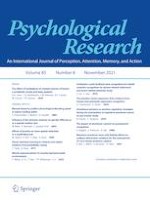03-01-2021 | Original Article
Does attention solve the “apples-and-oranges” problems of judging task difficulty and task order?
Gepubliceerd in: Psychological Research | Uitgave 8/2021
Log in om toegang te krijgenAbstract
How do we compare the difficulty of different kinds of tasks, and how we do sequence tasks of different kinds when the basis for the ordering is the tasks’ difficulty levels? The ability to do these things requires a common currency, but the identity of that currency, if it exists, is unknown. We hypothesized that people may believe that the time that attention is paid to tasks enables people to compare and sequence tasks of different kinds. To evaluate this hypothesis, we tested three groups of participants. One group estimated the proportion of time that performance of a task requires attention—what we called attention time proportions or ATPs. We obtained ATPs for tasks that were “more intellectual” (counting) and others that were “more physical” (locomotion). Two additional groups made 2-alternative-forced-choice decisions about the relative ease and preferred sequencing of all possible pairs of tasks for which ATPs were independently obtained. We found that ATPs predicted judgments of task difficulty and preferred task order.
